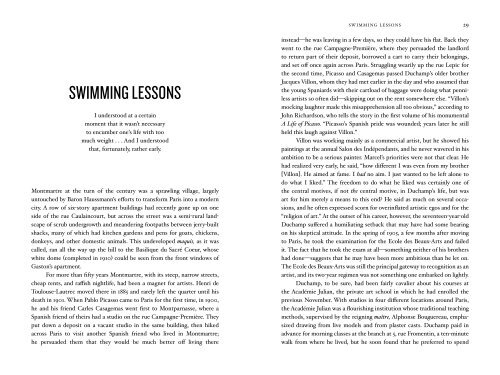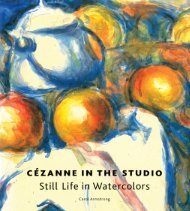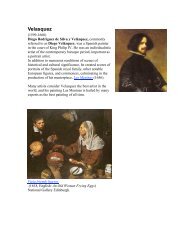swimming lessons 29Swimming LessonsI understood at a certainmoment that it wasn’t necessaryto encumber one’s life with toomuch weight . . . And I understoodthat, fortunately, rather early.Montmartre at the turn of the century was a sprawling village, largelyuntouched by Baron Haussmann’s efforts to transform Paris into a moderncity. A row of six-story apartment buildings had recently gone up on oneside of the rue Caulaincourt, but across the street was a semi-rural landscapeof scrub undergrowth and meandering footpaths between jerry-builtshacks, many of which had kitchen gardens and pens for goats, chickens,donkeys, and other domestic animals. This undeveloped maquis, as it wascalled, ran all the way up the hill to the Basilique du Sacré Coeur, whosewhite dome (completed in 1910) could be seen from the front windows ofGaston’s apartment.For more than fifty years Montmartre, with its steep, narrow streets,cheap rents, and raffish nightlife, had been a magnet for artists. Henri deToulouse-Lautrec moved there in 1885 and rarely left the quarter until hisdeath in 1901. When Pablo Picasso came to Paris for the first time, in 1900,he and his friend Carles Casagemas went first to Montparnasse, where aSpanish friend of theirs had a studio on the rue Campagne-Première. Theyput down a deposit on a vacant studio in the same building, then hikedacross Paris to visit another Spanish friend who lived in Montmartre;he persuaded them that they would be much better off living thereinstead—he was leaving in a few days, so they could have his flat. Back theywent to the rue Campagne-Première, where they persuaded the landlordto return part of their deposit, borrowed a cart to carry their belongings,and set off once again across Paris. Struggling wearily up the rue Lepic forthe second time, Picasso and Casagemas passed <strong>Duchamp</strong>’s older brotherJacques Villon, whom they had met earlier in the day and who assumed thatthe young Spaniards with their cartload of baggage were doing what pennilessartists so often did—skipping out on the rent somewhere else. “Villon’smocking laughter made this misapprehension all too obvious,” according toJohn Richardson, who tells the story in the first volume of his monumentalA Life of Picasso. “Picasso’s Spanish pride was wounded; years later he stillheld this laugh against Villon.”Villon was working mainly as a commercial artist, but he showed hispaintings at the annual Salon des Indépendants, and he never wavered in hisambition to be a serious painter. Marcel’s priorities were not that clear. Hehad realized very early, he said, “how different I was even from my brother[Villon]. He aimed at fame. I had no aim. I just wanted to be left alone todo what I liked.” The freedom to do what he liked was certainly one ofthe central motives, if not the central motive, in <strong>Duchamp</strong>’s life, but wasart for him merely a means to this end? He said as much on several occasions,and he often expressed scorn for overinflated artistic egos and for the“religion of art.” At the outset of his career, however, the seventeen-year-old<strong>Duchamp</strong> suffered a humiliating setback that may have had some bearingon his skeptical attitude. In the spring of 1905, a few months after movingto Paris, he took the examination for the Ecole des Beaux-Arts and failedit. The fact that he took the exam at all—something neither of his brothershad done—suggests that he may have been more ambitious than he let on.The Ecole des Beaux-Arts was still the principal gateway to recognition as anartist, and its two-year regimen was not something one embarked on lightly.<strong>Duchamp</strong>, to be sure, had been fairly cavalier about his courses atthe Académie Julian, the private art school in which he had enrolled theprevious November. With studios in four different locations around Paris,the Académie Julian was a flourishing institution whose traditional teachingmethods, supervised by the reigning maître, Alphonse Bouguereau, emphasizeddrawing from live models and from plaster casts. <strong>Duchamp</strong> paid inadvance for morning classes at the branch at 5, rue Fromentin, a ten-minutewalk from where he lived, but he soon found that he preferred to spend
30 duchamp swimming lessons 31the mornings playing billiards at his local café. His main artistic activityduring this period was jotting down quick visual impressions in a pocketsketchbook. “That was the fashion among artists,” as he recalled it. “Youhad to have a sketchbook in your pocket all the time, ready for action at anyprovocation from the physical world.” One of the few surviving <strong>Duchamp</strong>sketchbooks shows quick pencil impressions of his brothers and sisters,of Jacques Villon’s dog, and—interestingly, in the light of his future LargeGlass—several pages of pencil-and-watercolor drawings of working-classParisians in the distinctive uniforms or work clothes of their occupation:policeman, knife grinder, gas man, vegetable peddler, street sweeper, funeralcoachman, undertaker.For <strong>Duchamp</strong>, who valued his freedom so highly, the new conscriptionlaw passed by the legislature that spring came as an unpleasant surprise.Instead of three years’ military service for a relatively few individuals whowere selected by lot, the new law made all healthy young Frenchmen subjectto a two-year enlistment—with the exception of doctors, lawyers, and someothers who were engaged in what the inscrutable French state consideredessential professions, and who could get off (as Gaston <strong>Duchamp</strong> had donebecause he was a law student) with serving only one year. One of these essentialprofessions happened to be “art workers” (ouvriers d’art)—not artists,but printers, engravers, and other skilled technicians in what we would callthe applied arts. Faced with the prospect of two years in uniform, <strong>Duchamp</strong>decided to become an ouvrier d’art. He cut short his paid-up classes at theAcadémie Julian and left Paris in May to go to work as an apprentice atthe Imprimerie de la Vicomte, a well-established print shop in Rouen. WhyRouen? The main reason was that his parents had recently moved there.Eugène <strong>Duchamp</strong>, financially secure after twenty-two years as Blainville’snotary and ten as its mayor, had retired early in 1905, sold the house andthe notarial practice, and taken a comfortable two-floor apartment on therue Jeanne d’Arc in his wife’s beloved city of birth. Here Marcel settled onceagain into family life.Five months later, having mastered the techniques of etching, engraving,and typesetting, he took an examination in his new trade. The examiningboard in Rouen “was composed of master craftsmen,” he recalled, “whoasked me a few things about Leonardo da Vinci. As to the written part, soto speak, you had to show what you could do by way of printed engravings.”<strong>Duchamp</strong> had procured for this purpose one of his grandfather EmileNicolle’s copper plates of The Hundred Towers of Rouen, a very popular seriesin its time, and he pulled from the press a print of this plate for everymember of the jury. “They were enchanted,” he said. “They gave me 49 outof a possible grade of 50.” With his certificate as an ouvrier d’art in hand,<strong>Duchamp</strong> presented himself to the military authorities on October 3 andreported for duty the following day with the 39th Infantry Regiment inRouen.Very little is known about his military service other than that he wasstationed not far from Rouen in the town of Eu, promoted to corporal inApril, and discharged in October 1906. He headed straight back to Paris,where he rented a bachelor flat at 65, rue Caulaincourt, a few doors downthe hill from Gaston’s former lodgings. For the first time he was completelyon his own, both his brothers having recently moved to the quiet ruralsuburb of Puteaux, just across the Seine from Neuilly on the city’s westernoutskirts. Jacques Bon, Raymond’s artist brother-in-law, had discovered agroup of inexpensive “pavilions with artist’s studios,” with a shared gardenin back, at 7, rue Lemaître in Puteaux. Gaston took one of them, Raymondand Yvonne took another, and the Czech artist Frantisek Kupka, a formerneighbor of Gaston’s on the rue Caulaincourt, moved into a third, creatingon the spot an artists’ colony that would give Puteaux a place in art history.For Gaston—or Jacques Villon, as he wished to be known and will be knownfrom now on in these pages—the move was a lifesaver. The Bohemian atmosphereof Montmartre had never agreed with his easily imposed-on goodnature. “The worst thing for me was when my friends started to encroachon me,” Villon told Pierre Cabanne. “They came over to smoke their pipes,brought along their women, and stopped me working. I had to make up atnight for the time they wasted during the day.” He lived in Puteaux for therest of his life, virtually ignored by the art establishment until, in his seventies,the fame that he had long since stopped thinking about sought himout at last.<strong>Duchamp</strong>’s year in the army gave his recovered freedom a delicioussavor. Instead of re-entering the Académie Julian, he slipped easily into therole of a flâneur—a detached observer of the passing scene, whose artisticleanings required no undue expenditure of effort. He saw a lot of his formerclassmate Pierre Dumont, who was also living the artist’s life in Montmartre,and he formed a lifelong bond with Gustave Candel, the son of a prosperouscheese merchant, who lived with his parents at 105, rue Caulaincourt.




